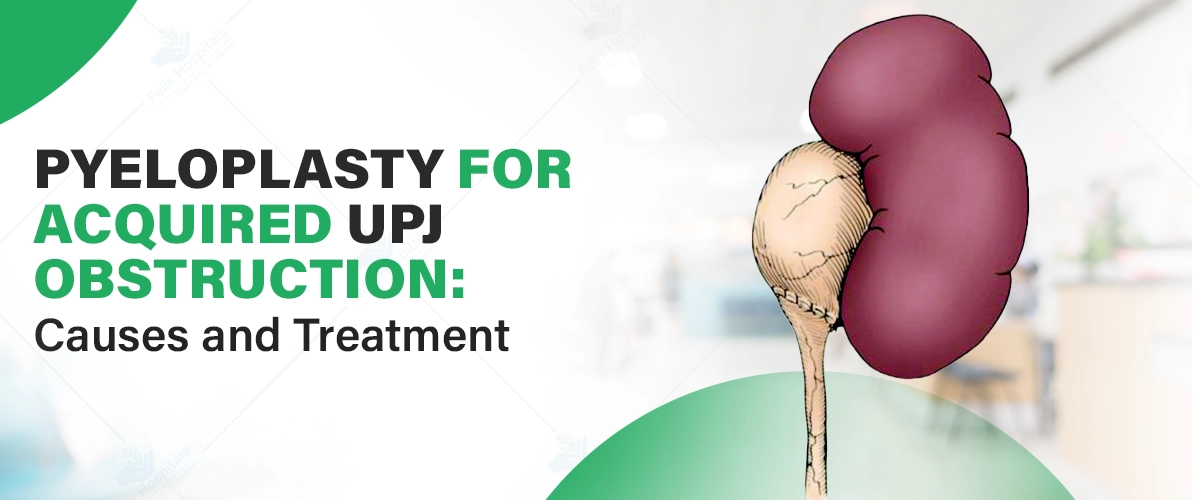
Subscribe to our

Ureteropelvic Junction (UPJ) obstruction is a condition that disrupts the normal flow of urine from the kidney to the bladder. It occurs when the junction between the renal pelvis and the ureter becomes blocked, leading to kidney dysfunction. While some individuals are born with this condition, known as congenital UPJ obstruction, others may develop it later in life, which is referred to as acquired UPJ obstruction. Timely diagnosis and treatment are crucial to prevent long-term damage to the kidneys. One of the most effective treatment options for acquired UPJ obstruction is pyeloplasty, a surgical procedure designed to correct the blockage and restore normal kidney function. Choosing the best hospital for pyeloplasty surgery ensures high-quality care and improves the likelihood of a successful outcome.
Acquired UPJ obstruction is a condition that develops later in life and occurs when external factors such as injury, infection, or scarring block the junction between the renal pelvis and the ureter. This blockage can cause urine to back up into the kidney, potentially leading to kidney damage if left untreated.
Several factors can lead to acquired UPJ obstruction, including:
The symptoms of acquired UPJ obstruction often develop gradually and may include:
Pyeloplasty in ureteropelvic junction obstruction is the preferred treatment for patients with severe cases of UPJ obstruction. This surgical procedure involves removing the blocked portion of the ureter and reconnecting the remaining ureter to the renal pelvis, restoring the flow of urine.
The treatment can be performed through open surgery or minimally invasive techniques, such as laparoscopic or robotic pyeloplasty. Minimally invasive pyeloplasty has become increasingly popular due to its shorter recovery time and reduced risk of complications. Success rates for pyeloplasty are generally high, with most patients experiencing significant improvement in kidney function and quality of life.
Before undergoing pyeloplasty, patients will undergo several preparatory steps, including preoperative assessments to ensure they are suitable candidates for surgery. The procedure itself involves:
Post-surgery, patients typically recover in a hospital setting for a few days. Pain management and follow-up care are essential to ensure a smooth recovery.
While pyeloplasty is considered the gold standard for treating acquired UPJ obstruction, other treatment options exist:
Recovery from pyeloplasty depends on the complexity of the surgery and the patient’s overall health. Generally, patients can expect:
When seeking treatment for UPJ obstruction, it is crucial to consult an experienced urologist. The best urologist at Felix Hospital can assess the severity of the obstruction and determine the best course of treatment. Factors such as the patient’s age, health status, and the severity of the obstruction must be considered.
If you’re seeking the best pyeloplasty doctors in Noida, Dr. Bhanwar Lal Barkesiya at Felix Hospital is an expert in handling complex urological conditions, including UPJ obstruction. With years of experience in performing pyeloplasty, Dr. Barkesiya can offer tailored solutions to ensure optimal results for his patients.
Early detection and timely treatment of UPJ obstruction are vital for preserving kidney function and preventing further complications. Pyeloplasty in ureteropelvic junction obstruction offers an excellent long-term solution for patients with severe blockages. If you experience symptoms such as flank pain, recurrent UTIs, or kidney swelling, it’s essential to seek medical advice immediately.
The pyeloplasty surgery cost in Noida may vary depending on the complexity of the case and the hospital chosen. However, the benefits of early intervention far outweigh the potential costs of untreated obstruction. With advancements in minimally invasive techniques, pyeloplasty is becoming an even more efficient and effective option for patients with UPJ obstruction.
Q- What are the key differences between congenital and acquired UPJ obstruction?
Ans- Congenital UPJ obstruction is present from birth, while acquired UPJ obstruction develops later due to factors like kidney stones, trauma, or infections.
Q- How long does it take to recover from pyeloplasty surgery?
Ans- Minimally invasive surgery takes 2-3 weeks, while open surgery requires 4-6 weeks for recovery.
Q- Are there any alternatives to pyeloplasty for acquired UPJ obstruction?
Ans- Alternatives include endopyelotomy, balloon dilation, and ureteral stenting, but pyeloplasty is the most effective treatment.
Q- Can acquired UPJ obstruction be caused by medications or medical treatments?
Ans- Certain treatments may increase infection or scarring risk, potentially contributing to UPJ obstruction.
Q- What are the most common symptoms of acquired UPJ obstruction?
Ans- Symptoms include flank pain, UTIs, blood in the urine, and kidney swelling.
Q- How is UPJ obstruction diagnosed, and what tests are involved?
Ans- Diagnosis involves ultrasound, CT scan, IVP, and renal scans to locate and evaluate the obstruction.
Q- What is the long-term success rate of pyeloplasty surgery?
Ans- Pyeloplasty has a high success rate with long-term relief and improved kidney function. Regular follow-ups are essential.